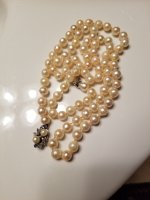Lagoon Island Pearls
Well-known member
- Joined
- Dec 8, 2009
- Messages
- 2,143
Again, very nice views. As mentioned previously, there are difficulties reading the signature when I don't have exemplars to compare.
So with that, I'll draw on how a typical tissue grafted non-beaded nucleus appears. More often than not, the nucleus appears as a scroll, where mantle tissue being cut, then slightly curled along the ends by natural elasticity. Even though these may be crude in appearance, they are often described as quasi-geometrical. After all, they originated from a near perfect square at the time they were sectioned.
I'm clearly seeing a square in two images, but not necessarily in the others. There are secondary contrasts near the darker contrast which appear as lobes radiating in random directions from the nucleus. Being a teardrop pearl, the wide end is proximal, while the pointed end is distal in this instance. The nucleus is subsurface, offset from the centre. Dark patches highlight juvenile (periostracial) growth. In cultured pearls this is almost always situated closely proximal to the heart.
This is a tough one. You've done well to provide additional images. I'm certainly impressed and intrigued, however not swayed from my initial assessment, which is inconclusive.
For those reasons, I'm leaning cultured, but cannot dismiss some properties observed in natural pearls. Properties not uncommon in most pearls.
Sending it to the lab is a difficult decision, but 60/40 culture/natural still merits a trip to the lab, especially if you find it affordable. Otherwise you may be satisfied by the mystery of unknowing, even after the experts have weighed in.
The entire piece itself was likely crafted around the pearl. Assuredly an unique mounting. It's a significant value add, irrespective of the pearl origin.
Either way, it's a remarkable ring and I thank you for sharing it with us.
So with that, I'll draw on how a typical tissue grafted non-beaded nucleus appears. More often than not, the nucleus appears as a scroll, where mantle tissue being cut, then slightly curled along the ends by natural elasticity. Even though these may be crude in appearance, they are often described as quasi-geometrical. After all, they originated from a near perfect square at the time they were sectioned.
I'm clearly seeing a square in two images, but not necessarily in the others. There are secondary contrasts near the darker contrast which appear as lobes radiating in random directions from the nucleus. Being a teardrop pearl, the wide end is proximal, while the pointed end is distal in this instance. The nucleus is subsurface, offset from the centre. Dark patches highlight juvenile (periostracial) growth. In cultured pearls this is almost always situated closely proximal to the heart.
This is a tough one. You've done well to provide additional images. I'm certainly impressed and intrigued, however not swayed from my initial assessment, which is inconclusive.
For those reasons, I'm leaning cultured, but cannot dismiss some properties observed in natural pearls. Properties not uncommon in most pearls.
Sending it to the lab is a difficult decision, but 60/40 culture/natural still merits a trip to the lab, especially if you find it affordable. Otherwise you may be satisfied by the mystery of unknowing, even after the experts have weighed in.
The entire piece itself was likely crafted around the pearl. Assuredly an unique mounting. It's a significant value add, irrespective of the pearl origin.
Either way, it's a remarkable ring and I thank you for sharing it with us.











